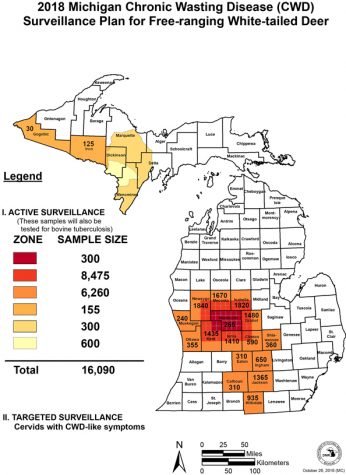Zombie Deer
Screen shot of NBC news broadcast taken by Peter Massura
Deer infected by CWD.
In recent months, a new threat has risen in the United States. Many are calling it “Zombie Deer Disease,” but its official name is Chronic Wasting Disease (CWD).
Brought to light by social media platforms such as Twitter, Instagram, and Facebook, CWD has been illustrated through videos and memes which show deer acting spastically. As CWD becomes more mainstream, many questions are asked, answered in the FAQ section of the official CWD webpage. Fortunately for us, CWD is unlike the Hollywood zombie diseases, which cause the infected to crave flesh and brains of the living. The CWD phenomenon is still concerning, however, because it causes infected deer to become very skinny and confused. This ultimately leads to death due to starvation, hypothermia, or the inability to defend themselves from outside forces.
“(CWD is like) deer dementia,” said freshman Ellie Meseri.
The spread of disease started in the Great Plains of the United States around 2000. Ten years later, in 2010, CWD spread amongst more than ten states nationwide. Just eight years later, in 2018, CWD was seen in deer in over 25 states nationwide: that’s half of the continental United States. At this rate, it should only take around ten years until CWD is visible and active in all 48 states of the continental U.S. Of the 25 states in which CWD can be seen in deer, there have been numerous reports from hunters and citizens claiming to have seen infected deer. The reports consist of similar situations, including lack of coordination, drooling, drooping ears, and a strange lack of fear to humans. The disease was first discovered in Michigan in a free-ranging deer in May 2015. To date, more than 31,000 deer in Michigan have been tested for CWD, and CWD has been confirmed in 60 free-ranging deer in six Michigan counties: Clinton, Ingham, Ionia, Jackson, Kent, and Montcalm. As of now, CWD has not been reported in Oakland County, but as the weather starts to warm up and more deer start migrating, it is a safe bet to say CWD will, in fact, make its way around the state and the country.

The multiple ways CWD attacks victims.
“CWD is spreading like wildfire,” said sophomore Mitchell Bowery.
Scientists have reason to believe that CWD cannot be contracted by most domesticated animals including cats, dogs, and cattle. Wyoming did a 13-year study in which cows were put in deer pens heavily infected with CWD, and none of the cows became infected.
”I’m glad my dog cannot get this because we have a lot of deer near my house,” said junior Tia Benavides.
CWD is fatal in any animals able to contract the disease. Fortunately, there have been zero reported cases of CWD in humans. Many scientists believe that if humans consume the meat of an infected deer that humans would contract the disease due to an experiment primates, who were fed meat contaminated with CWD and in fact contracted the illness. As of right now, CWD may not affect the day-to-day lives of humans, but CWD is not a viral or bacterial disease, it is a prion disease, which means it attacks the proteins of the victim.
Prion diseases are a danger to humanity because scientists have not yet been able to find a cure for them. CWD is caused by a normal protein, called a prion, that folds incorrectly and can infect other deer. The disease is transmitted through direct animal to animal contact or through saliva, urine, feces, blood, and carcass parts of an infected animal or infected soil. Prions are extremely resistant to the environment and can stay infectious for years. Plants then go on to absorb prions from contaminated soil and transport them to different parts of the plant. By doing this, the plants can act as a carrier of CWD. Another popular theory is that CWD is not a prion disease, but rather a bacterial disease. A doctor, Jon Luongo, who believes CWD is bacterial, has also made obscure claims, such as nearly 15% of all Alzheimer’s diagnosis are actually Creutzfeldt-Jakob disease, or mad cow disease contracted by humans.

Counties in Michigan with CWD infected deer.
“I’ve never heard of a prion diseases… very scary,” said sophomore Tyler Boeve.
This disease could be catastrophic to humanity because as everything evolves, even diseases, and the evolution of CWD may cause an epidemic. A predicted CWD new word would consist of many different strains of the disease, as the prions are constantly changing and evolving. This would be extremely dangerous to humans as there is already no cure, and more strains would make research and development of CWD cures exponentially more difficult. Luckily, this “Zombie Deer Disease” does not cause the flesh and brain cravings expected, but that does not mean it does not come with its own set of dangers and potential risks.







